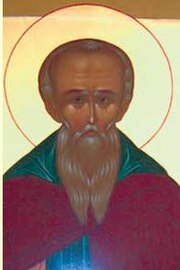Top Qs
Timeline
Chat
Perspective
August 8 (Eastern Orthodox liturgics)
From Wikipedia, the free encyclopedia
Remove ads
August 7 - Eastern Orthodox liturgical calendar - August 9

All fixed commemorations below are observed on August 21 by Eastern Orthodox Churches on the Old Calendar.[note 1]
For August 8, Orthodox Churches on the Old Calendar commemorate the Saints listed on July 26.
Feasts
- Afterfeast of the Transfiguration of Our Lord, God, and Savior Jesus Christ.[1][note 2]
Saints
- Saint Myron the Wonderworker, Archbishop of Crete (350)[1][3][4][5][note 3]
- Martyrs Eleutherius and Leonides, of Constantinople, and many infants with them, by fire (4th century)[1][4][6][7][8]
- Martyr Gormizdas (Hormisdas) of Persia (418)[1][6][9][10]
- The Ten Venerable ascetics of Egypt.[11][12]
- The two martyrs of Tyre, dragged to death.[13][12]
- Martyr Styracius, by the sword.[4][14]
- Saint Emilian the Confessor, Bishop of Cyzicus (820)[1][4][15][16][note 4] (see also: January 8)
Remove ads
Pre-Schism Western saints
- Saints Cyriacus, Largus, Smaragdus and Companions, a group of twenty-four martyrs who suffered in Rome under Diocletian (304)[17][note 5]
- Saint Severus, a priest who came from India to enlighten the area around Vienne in France (c. 445)[17][note 6]
- Saint Leobald (Leodebod, Leodebaldus), founder of Fleury Abbey, later called Saint-Benoît-sur-Loire, near Orleans in France (650)[17]
- Saint Mummolus (Mommolus, Mommolenus), second Abbot of Fleury in France (c. 678)[17][note 7]
- Saint Sigrada, mother of Sts Leodegarius and Warinus, nun at the convent in Soissons in France (c. 678)[17]
- Saint Ternatius (Terniscus), eleventh Bishop of Besançon in the east of France (c. 680)[17]
- Saint Ellidius (Illog), Patron-saint of Hirnant in Powys in Wales and of a church in the Scilly Isles (7th century)[17]
- Saint Gedeon, the thirteenth Bishop of Besançon in France (796)[17]
- Saint Ultan, priest at the monastery of St Peter in Crayke in Yorkshire (8th century)[17][note 8]
- Saint Rathard (Rathard von Andechs), a noble who became a priest and founded the monastery of Diessen (Dießen-Andechs) in Germany (815)[17]
Post-Schism Orthodox saints
- Venerable Theodosius the New, Igumen of Orov.[4][18]
- Venerable Gregory, Iconographer, of the Kiev Caves (12th century)[1][4][9][19]
- Venerable Gregory of Sinai (Mt. Athos) (1346)[1][9][20]
- Saint Zosimus the Sinaite, of Tuman Monastery, Serbia (14th century)[1][9]
- Saint Gregory, Wonderworker, of the Kiev Caves (14th century)[1][9]
- New Martyr Triantaphyllos of Zagora, Thessaly, at Constantinople (1680)[1][4][21][22][note 9]
- New Martyr Anastasius (Spaso) of Radovishte in Strumica, at Thessaloniki (1794)[1][4][9][23]
- Monkmartyr Euthymius, Abbot of the Monastery of St. John the Baptist, at David Gareja monastery complex, Georgia (1804)[1][9][24]
- Saint Philaret of Ichalka, Ivanovo (1913)[1][9][10]
- Saint Kallinikos (Poulos) of Edessa, Metropolitan of Edessa, Pella and Almopia (el) (1984)[25][26][note 10]
New martyrs and confessors
Remove ads
Other commemorations
- Consecration of the Church of the Apostles Peter and Paul, in the year 891 AD (6399 AM), in reign of Leo VI the Wise, when there occurred a solar eclipse from the sixth to the ninth hours.[29][30]
- Consecration of the Church of the Most Holy Theotokos in Jerusalem.[31]
- "Tolga" Icon of the Most Holy Theotokos (1314)[1][32][33]
- First (1566) and second (1992) translations of the relics of Sts. Zosimas (1478) and Sabbatius (1435), of Solovki.[1][9][34][note 12]
- Translation of the relics (1992) of St. Herman of Solovki (1479)[1][9]
- Uncovering of the relics (2002) of St. Barlaam of Chikoisk Monastery (Siberia)[note 13] (1846)[1]
Remove ads
Icon gallery
- New Hieromartyr Nicodemus (Krotkov).
- St. Herman of Solovki.
- St. Barlaam of Chikoisk Monastery (Siberia).
Notes
- The notation Old Style or (OS) is sometimes used to indicate a date in the Julian Calendar (which is used by churches on the "Old Calendar").
The notation New Style or (NS), indicates a date in the Revised Julian calendar (which is used by churches on the "New Calendar"). - The hymns at Vespers today speak of the sun appearing dim compared to the divine light of the Transfiguration. In His compassion for humanity, Christ took on mortal flesh, yet Peter, James and John saw the radiance of His glory. The incarnate Lord “made Adam’s darkened image to shine again” when He appeared on earth “arrayed in the original beauty of the Image (Genesis 1:26).[2]
- "In Crete, St. Myron, a bishop renowned for miracles."[6] See also: (in Greek) Άγιος Μύρων (επίσκοπος). Βικιπαίδεια. (Greek Wikipedia).
- "AT Rome, the holy martyrs Cyriacus, deacon, Largus, and Smaragdus, with twenty others, who suffered on the 16th of March, in the persecution of Diocletian and Maximian. Their bodies were buried on the Salarian road by the priest John, but were on this day translated by pope St. Marcellus to the estate of Lucina, on the Ostian way. Afterwards they were brought to Rome, and placed in the Church of St. Mary in Via Lata."[6]
- He had relics of Sts Benedict and Scholastica brought from Italy and so Fleury came to be known as Saint-Benoît-sur-Loire.
- He was officially glorified by the Holy Synod of the Ecumenical Patriarchate on June 23, 2020, to be commemorated each year on August 8. The official statement from the Ecumenical Patriarchate was as follows:
- (in Greek) "α) ἀπεφασίσθη, ἐπί τῇ βάσει ἐκθέσεως τῆς Κανονικῆς Ἐπιτροπῆς, ἡ ἁγιοκατάταξις τοῦ μακαριστοῦ Μητροπολίτου Ἐδέσσης καί Πέλλης κυροῦ Καλλινίκου, τῆς μνήμης αὐτοῦ μελλούσης ἑορτάζεσθαι τῇ 8ῃ Αὐγούστου."[27]
- He was canonized in the Kostroma diocese in 1995 as a local saint, to be venerated by believers during the Synaxis of the Saints of Kostroma (January 23). In 2000 he was included among the New Martyrs and Confessors of Russia, by the Russian Orthodox Church.
- "The patrons of Ukrainian beekeepers, Savvatij and Zossima more than likely were tonsured at the Kyiv Caves Lavra before going to Solovki where they introduced beekeeping. Their icons are often placed in outdoor shrines among bee-hives together with those of St John the Baptist and St Alexius the Man of God."[35]
- See also: Чикойский Иоанно-Предтеченский монастырь. Википедии (Russian Wikipedia).
Remove ads
References
Sources
Wikiwand - on
Seamless Wikipedia browsing. On steroids.
Remove ads




